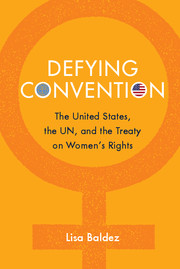Book contents
- Frontmatter
- Dedication
- Contents
- Acknowledgments
- 1 Introduction
- 2 A Scaffolding for Global Women’s Rights, 1945–1970
- 3 Geopolitics and Drafting the UN Treaty on Women’s Rights
- 4 An Evolving Global Norm of Women’s Rights
- 5 CEDAW Impact: Process, Not Policy
- 6 Why the United States Has Not Ratified CEDAW
- 7 CEDAW and Domestic Violence Law in the United States
- 8 Conclusion
- Works Cited
- Index
5 - CEDAW Impact: Process, Not Policy
Published online by Cambridge University Press: 05 August 2014
- Frontmatter
- Dedication
- Contents
- Acknowledgments
- 1 Introduction
- 2 A Scaffolding for Global Women’s Rights, 1945–1970
- 3 Geopolitics and Drafting the UN Treaty on Women’s Rights
- 4 An Evolving Global Norm of Women’s Rights
- 5 CEDAW Impact: Process, Not Policy
- 6 Why the United States Has Not Ratified CEDAW
- 7 CEDAW and Domestic Violence Law in the United States
- 8 Conclusion
- Works Cited
- Index
Summary
In 2009, a Malaysian NGO posted a short video about CEDAW on YouTube. The video begins with black and white footage of three teenagers, two boys and a girl, jumping rope. A second girl stands hesitantly to the side. She tries to jump in but falls, then refuses help from the others. As this footage unfolds, these words flash across the screen:
BEFORE CEDAW
Violence in the home was not a crime
Married mothers were not the guardians of their children
Federal constitution did not prohibit gender discrimination
50% of the population are women but less than 5% of politicians were women
Then the screen goes black and we read:
Malaysia ratified CEDAW in 1995.
The screen cuts back to the kids jumping rope, this time in color. The second girl, now happy and confident, jumps in with one of the boys. We read:
Domestic violence is now a crime.
Non-Muslim married men and women are equal guardians of their children.
Gender discrimination is forbidden under the Federal Constitution.
Government plans for 30% women to be decision makers
(Women’s Candidacy Initiative 2009).The video depicts CEDAW as the key variable that made the difference between weak and strong rights for women. Before Malaysia ratified CEDAW, the government did not protect women from discrimination; after Malaysia ratified CEDAW, the government moved quickly to adopt laws guaranteeing women’s rights. Before CEDAW, women were weak and vulnerable; after CEDAW, women participate fully in civic life and everyone is happy. In the video, CEDAW is like a light switch: ratifying it has an immediate and powerful effect on state policy.
- Type
- Chapter
- Information
- Defying ConventionUS Resistance to the UN Treaty on Women's Rights, pp. 130 - 151Publisher: Cambridge University PressPrint publication year: 2014
- 1
- Cited by



